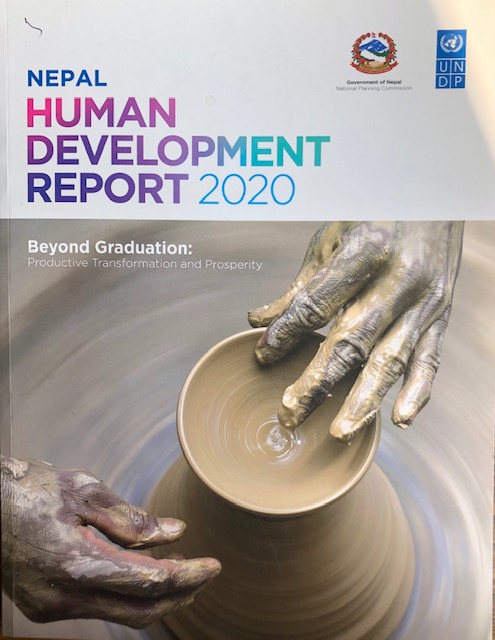Nepal Human Development Report 2020
Nepal Human Development Report 2020
Beyond Graduation: Productive Transformation and Prosperity

National Planning Commission has been publishing the Nepal Human Development Report since 1998, with the focus shifting considering the needs of the country. The Nepal Human Development Report 2020: Beyond LDC Graduation: Productive Transformation and Prosperity is the latest in series since its first publication in 1998. The recently published report has focused on how Nepal could meaningfully advance towards sustainable human development at a faster pace.
The report uncovers inequalities across Nepal, particularly within some provinces, denoting a wide variation in productive capabilities and opportunities. The report also suggests narrowing these gaps with a more radical strategic shift in both the supply and demand side of the economy, specifically focusing on complementary investment in empowering people through voice and choice, as well as the accountability of all levels of decision-making towards an empowerment agenda.
The report also alerts that in the post-graduation era, Nepal faces potential export losses and erosion in concessional aid, although reductions may not be very high in the short to medium term. Other risks may stem from less favorable bilateral aid terms and the phasing out of some United Nations mechanisms and other supports. A very robust transitional strategy for graduation is required to help minimize risks and maximize gains. The COVID-19 pandemic does pose a big challenge to overall human development in Nepal. For the first time in 30 years, the progress on HDI is likely to be negative.
As per the report Nepal’s national HDI score stood at 0.587 in 2019, which puts the country in the medium human development category. Its score in urban areas (0.647) surpasses that of rural areas (0.561) with a large urban-rural gap. Higher per capita income and better access to education and health services in urban areas explain such striking disparities. The HDI value also varies across provinces. As expected, Bagmati province scores the highest (0.66), followed by Gandaki province (0.62). Province 2 scores the lowest (0.51) followed by Karnali (0.538). This indicates the uneven distribution of development outcomes across different parts of the country.
Nepal’s overall human development loss due to inequality is below the loss experienced by most South Asian countries, except Bangladesh, the Maldives and Sri Lanka. Nepal is behind all South Asian countries in terms of inequality in income, however, having among the highest disparities in the region despite relatively lower inequality in health and education.
The female HDI value for Nepal is 0.549, compared to 0.619 for males. It suggests that the degree of gender disparity in human development in Nepal as a whole is not very high, with the female HDI value only 11.3 percent lower than that of males. Nepal’s GDI value reached 0.886 in 2019 from 0.75 in 1995, an increase of 18 percent.
The HDR 2020 report reveals that Nepal’s 2019 Gender Inequality Index (GII) value is 0.479. This is consistent with the 2018 value of 0.476 reported in the 2019 global Human Development Report. It indicates a fairly moderate level of gender inequality in Nepal. Similarly Nepal’s score on customs administration is the lowest and on timeliness is highest, but it is far from the best-performing country on any of the indicators. This shows that Nepal is inefficient in trade logistics.
The report appears at an unprecedented time, when not only Nepal but the entire world is struggling with the COVID-19 pandemic, which has slowed development momentum globally, with a high risk of fallback from a high growth trajectory. The pandemic requires a fresh review of the graduation plan. With sharp deceleration in economic growth, reductions in human assets and intensification of economic vulnerability, Nepal faces a changed situation. This necessitates a closer review of the scheduled graduation plan. Enhancing socioeconomic and environmental resilience by reducing vulnerabilities will likely be a crucial part of the transitional strategy.
The report presents a rigorous analysis of the socio-economic spectrum of the country, using available data across the country and across time, including a province-wise analysis. The findings have shown that some provinces are further behind than others in human and overall development.
